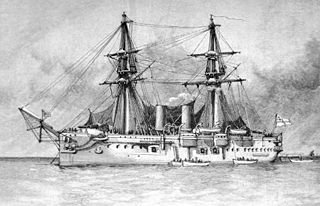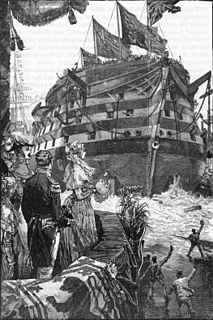
HMS Invincible was a Royal Navy Audacious-class ironclad battleship. She was built at the Napier shipyard and completed in 1870. Completed just 10 years after HMS Warrior, she still carried sails as well as a steam engine.

HMS Ganges was an 84-gun second-rate ship of the line of the Royal Navy, launched on 10 November 1821 at Bombay Dockyard, constructed from teak. She was the last sailing ship of the Navy to serve as a flagship, and was the second ship to bear the name.

HMS Britannia was a 120-gun first-rate ship-of-the-line of the Royal Navy, laid down in 1813 and launched on 20 October 1820.

The Audacious-class ironclad battleships were designed by Sir Edward Reed at the request of the Board of Admiralty to serve as second-class battleships on distant foreign stations.

HMS Temeraire was an ironclad battleship of the Victorian Royal Navy which was unique in that she carried her main armament partly in the traditional broadside battery, and partly in barbettes on the upper deck.
Five ships of the Royal Navy have been named HMS Hindustan or Hindostan, after the old name for the Indian subcontinent:

HMS Caledonia was a 120-gun first-rate ship of the line of the Royal Navy, launched on 25 June 1808 at Plymouth. She was Admiral Pellew's flagship in the Mediterranean.

HMS Northumberland was a 70-gun third-rate ship of the line of the Royal Navy, built at Deptford Dockyard and launched in 1705.

HMS Trafalgar was a 120-gun first-rate ship of the line of the Royal Navy, launched on 21 June 1841 at Woolwich Dockyard. HMS Trafalgar was the last ship to complete the successful Caledonia class.

HMS Boyne was a 98-gun second rate ship of the line of the Royal Navy, launched on 3 July 1810 at Portsmouth. On 12 February 1814 she took part with HMS Caledonia in a hot action against the French line-of-battle ship Romulus off Toulon; the French 74 managed to escape to Toulon by sailing close to the coast to avoid being surrounded. With the 1817 changes to the rating system Boyne was rerated as a 104-gun first rate ship.

HMS Nile was a two-deck 90-gun second-rate ship of the line of the Royal Navy, launched on 28 June 1839 at Plymouth Dockyard. She was named to commemorate the Battle of the Nile in 1798. After service in the Baltic Sea and the North America and West Indies Station, she was converted to a training ship and renamed HMS Conway, surviving in that role until 1953.

HMS Charles was a 96-gun first-rate ship of the line of the Royal Navy, built by Christopher Pett at Deptford Dockyard until his death in March 1668, then completed by Jonas Shish after being launched in the same month. Her name was formally Charles the Second, but she was known simply as Charles, particularly after 1673 when the contemporary Royal Charles was launched.

HMS Falkland was a 50-gun fourth-rate ship of the line of the Royal Navy, built by Holland of New Castle, New Hampshire, and purchased by the navy in 1696.

HMS Salisbury was a 50-gun fourth rate ship of the line of the Royal Navy, built by Richard and James Herring at Baileys Hard on the Beaulieu River in Hampshire, England and launched on 18 April 1698.
HMS Triumph was a 90-gun second rate ship of the line of the Royal Navy, launched at Chatham Dockyard on 2 March 1697. She was renamed HMS Prince in 1714.

HMS Swiftsure was a 70-gun third-rate ship of the line of the Royal Navy, launched in 1755 and in active service during the Seven Years' War. After a distinguished career at sea she was decommissioned in 1763 and sold into private hands ten years later.

HMS Lichfield was a 50-gun fourth-rate ship of the line of the Royal Navy, built at Portsmouth Dockyard and launched on 4 February 1695.

HMS Fisgard was a 46-gun fifth rate Leda-class frigate of the Royal Navy. She spent sixty years in service on a variety of duties.

HMS Fisgard was a shore establishment of the Royal Navy active at different periods and locations between 1848 and 1983. She was used to train artificers and engineers for the Navy.

HMS Gloucester was a 50-gun fourth-rate ship of the line built for the Royal Navy in the 1710s. She participated in the 1701–15 War of the Spanish Succession. The ship was burned to prevent capture after she was damaged in a storm during Commodore George Anson's voyage around the world in 1742.


















